In this article
Joshua Tree National Park presents a distinctive allure for boulderers worldwide, a place where stark desert beauty meets exhilarating physical puzzles. This joshua tree bouldering guide, a truly definitive bouldering guide, will navigate you through its unique geology, essential planning for your trip, the must-visit bouldering areas, and crucial safety protocols. We aim to equip both first-time visitors and seasoned pebble wrestlers with the knowledge to fully appreciate and conquer the joshua tree bouldering experience, tackling its many bouldering challenges.
Joshua Tree’s reputation as a world-class bouldering mecca is well-earned, primarily due to its characteristic Quartz Monzonite rock and an overwhelming abundance of boulder problems. Climbers are drawn to the unique blend of technical climbing offered by this specific granit, set against stunning desert landscap. However, this environment demands specific preparation to manage its challenges. This article, a comprehensive guide book for the joshua tre, will serve as your ultimate resource, covering the rock’s nature, seasonal timing, vital climbing gear, how to find your way through key bouldering zones like Hidden Valley Campground and The Outback—some of the most original bouldering destinations—safety measures, and respecting the delicate ecosystem and its vegetation. Are you ready to explore what makes J-Tree a top-tier climbing area for outdoor bouldering?
Understanding Joshua Tree’s Signature Landscape and Climate
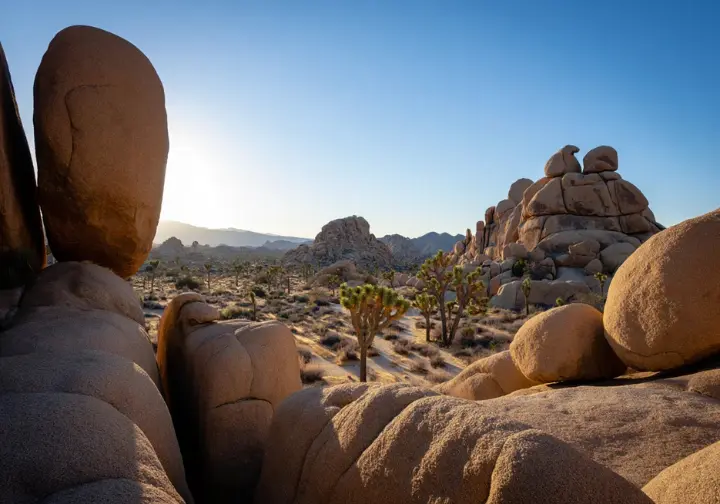
To truly appreciate and prepare for bouldering in Joshua Tree, understanding its unique bouldering environment is key. This involves familiarizing yourself with the geological makeup of its iconic boulders and the critical aspects of timing your visit according to its distinct desert seasons. This foundational knowledge, including insights into its bouldering history, will significantly shape your adventure in this massive park.
The Geologic Story: Why J-Tree Rocks are Special
The primary rock type you’ll encounter in Joshua Tree is Quartz Monzonite, a form of granite rock celebrated for its coarse texture. This texture offers superb friction for climbing but is also notoriously abrasive on skin and climbing gear. This rock began its journey millions of years ago as magma intrusions deep within the Earth’s crust. You can learn more about the origin of Joshua Tree’s granite landscape from geological studies, which form part of the geology of this mountain region.
Joshua Tree’s iconic tors, or rock piles, are the result of a fascinating multi-stage geological process. It starts with jointing, which is the fracturing of the granite. This is followed by chemical weathering, specifically spheroidal weathering, where water seeps into these joints, breaking down minerals and rounding the blocks of stone. For more information on similar processes, you can explore details on geological formations in national parks. These formations are what make the climbing here so unique.
The loose material, or regolith, created during this weathering process is eventually eroded away. This leaves behind the characteristic piles of rounded boulders that define Joshua Tree’s climbing terrain, with endless boulders to explore. This advanced stage of weathering is what distinguishes J-Tree from many other granitic climbing areas, perhaps even more so than areas like nearby Castle Rock State Park in terms of sheer boulder density.
Grasping the nature of this regional rock is fundamental for climbers. It directly influences climbing style, often demanding delicate footwork on crystals and slabs. It also dictates climbing gear choices, favoring durable climbing shoes (or rock shoes), and underscores the necessity for meticulous skin care to manage the abrasive surface of each boulder.
Best Seasons for Your Joshua Tree Bouldering Trip
Timing your joshua tree bouldering trip is paramount for an optimal experience. Fall, specifically from mid-October through December, is widely considered an ideal season for any climber. It brings temperate, sunny days and cooler temperatures after the intense summer heat, creating very comfortable climbing conditions on the rocks.
Winter, spanning December through February, is highly favored by many boulderers visiting joshua tre. The cooler temperatures can potentially enhance rock friction, a boon for challenging boulder problems. However, be prepared for chilly nights and the possibility of frost or even snow. Outside of holiday periods, the park might also be less crowded. For insights on seasonal climbing conditions in Joshua Tree, various resources are available, often found in any good bouldering book on the area.
Spring, from March through early May, offers another excellent window for climbing these granite mazes. Temperatures are generally mild, and you might even be treated to the sight of desert wildflowers. This period, however, can also be the busiest season in the park and may bring occasional windy days. When planning your Joshua Tree visit, consider these factors for your next joshua tree trip.
Summer, from late May to mid-October, presents extreme bouldering challenges. Scorching temperatures frequently exceed 100°F (38°C), making climbing not only very difficult but also risky; it’s generally best avoided for bouldering, or if attempted, requires extreme caution, focusing activity to the coolest parts of the day on any specific boulder.
Planning Your Joshua Tree Bouldering Expedition: A Practical Guide
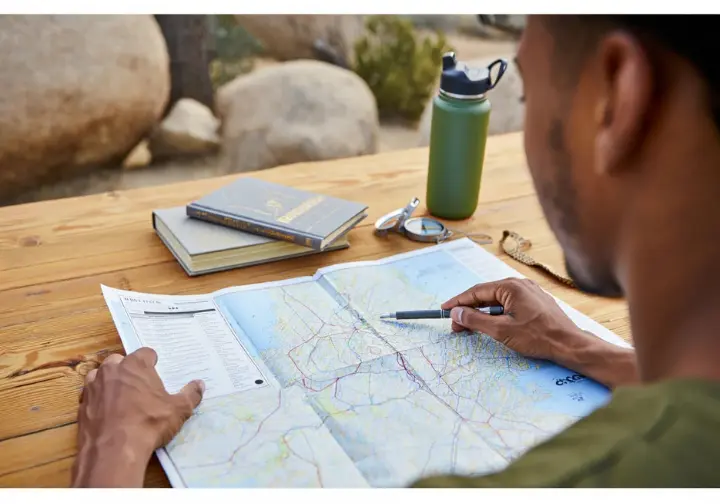
Effective planning is the cornerstone of any successful Joshua Tree bouldering trip. This section offers essential logistical information, covering how to reach the park, understand its fees and necessary permits, and select the best accommodation options, including joshua tree camping, to suit your bouldering adventure. Consider this your practical joshua tree bouldering guide to logistics.
Getting There: Park Entrances & Transportation
The closest major airport to Joshua Tree National Park is Palm Springs International (PSP), situated about an hour’s drive away. Other viable airport options include Ontario (ONT), Los Angeles (LAX), San Diego (SAN), and Las Vegas (LAS), though these involve longer drive times to reach the climbing areas.
The park itself is accessible via Interstate 10, which runs to its south, and California State Route 62, located to its north. You can find detailed directions to Joshua Tree National Park to plan your route effectively to the joshua tre.
There are three main entrances to the park: the West Entrance (the main one, in Joshua Tree town, or tree west), North Entrance (Twentynine Palms, often less congested), and South Entrance (near Cottonwood Spring, off I-10). Arriving early, particularly before 9 am during peak season, is strongly advised to secure parking at popular trailheads and bouldering areas. For current conditions, check the official park visitor information.
Park Logistics: Fees, Permits, and Key Facilities
All visitors to Joshua Tree National Park must have a valid entrance pass. Options include a 7-day vehicle pass ($30), a motorcycle pass ($25), an individual pass for those entering on foot or bicycle ($15), a specific Joshua Tree Annual Pass ($55), or various America the Beautiful passes which cover entry to all national park sites. You can find detailed information on park entrance fees and passes on the NPS website. Passes can be purchased online in advance (ensure you print or save a digital copy) or at entrance stations/visitor centers upon arrival. Some joshua tree outfitters might also sell passes.
Generally, no specific permit is required for bouldering itself beyond the standard park entrance fee. However, it’s important to know that permits for park activities are mandatory for any bolting activities, whether establishing new rock climbs or replacing existing bolts. Permits are also required for all overnight backcountry stays.
Visitor Centers, including the main Joshua Tree Visitor Center, Cottonwood Visitor Center, and Black Rock Nature Center, are valuable resources. They offer maps, sell passes, feature exhibits, and provide the most current information from park rangers. Cell service is notoriously unreliable throughout most of the park, so plan accordingly. Emergency telephones are available at Intersection Rock crag and the Indian Cove Ranger Station.
Accommodation: Camping Inside and Near the Park
In-park campgrounds such as Hidden Valley, Jumbo Rocks, and Ryan are exceptionally popular among boulderers due to their close proximity to numerous climbing areas and countless boulders. These sites generally offer limited amenities, typically vault toilets and no water at most locations. They fill up very quickly, so making reservations well in advance via recreation.gov is crucial for reservable sites. Some sites operate on a first-come, first-served basis, which can be competitive. You can get a Joshua Tree National Park campgrounds overview to see various joshua tree camping options.
Campgrounds like Indian Cove and Black Rock offer some sites that can be reserved and tend to have more amenities. This includes water access, either at the Indian Cove Ranger Station or within the Black Rock campground itself. For specific information, refer to Black Rock campground details. Cottonwood campground, located in the southern part of the park, also provides water and flush toilets.
Numerous private campgrounds and RV parks are available in the surrounding towns of Joshua Tree, Yucca Valley, and Twentynine Palms. These establishments typically offer a wider range of amenities, including showers, electricity, and water hookups, providing a more comfortable base for those who prefer it.
For visitors seeking more conventional lodging, hotels, motels, and an abundance of vacation rentals can be found in nearby communities, including the larger resort city of Palm Springs. While these options provide greater comfort and amenities, they necessitate daily travel into and out of the massive park.
Gearing Up: Your Essential Joshua Tree Bouldering Kit
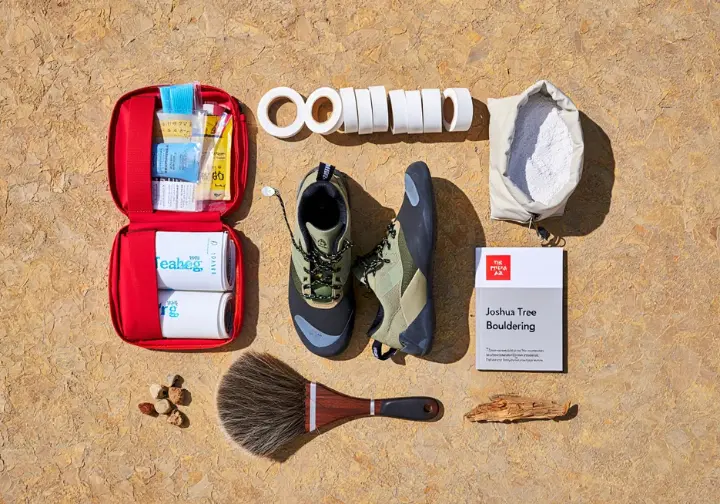
Packing the right climbing equipment is fundamental for tackling Joshua Tree’s unique granite. This section details the crucial climbing gear needed, focusing on climbing shoes appropriate for the sharp rock, adequate crash pads for safety, chalk for grip, essential skin care items, and the navigation tools vital for a safe and successful bouldering trip. This is the essential gear in your joshua tree bouldering guide.
Sole Survivors: Choosing Climbing Shoes for J-Tree Granite
The coarse Quartz Monzonite of Joshua Tree demands durable climbing shoes. The rubber should handle high friction and withstand significant abrasion. Stiffer rock shoes often excel for edging on the small, sharp crystals prevalent on many J-Tree problems. Finding the right climbing shoe fit is always important, but here, durability is also a prime concern for any climber.
Consider climbing shoes that offer good support for vertical faces and slabs, as these are common features in the park. While softer shoes can aid in smearing, the sharp nature of the rock frequently prioritizes edging capability and overall shoe durability. When choosing the best climbing shoes for J-Tree, think about this balance.
A snug, precise fit is paramount for trusting small footholds. However, avoid overly aggressive downturned shoes if much of your climbing will be on slabby terrain, as comfort over longer periods can be a factor. Some climbers opt for slightly more comfortable, all-around shoes for longer days or easier circuits due to the rock’s impact on feet and the need for effective slab climbing shoe techniques.
Given the crack features often encountered, especially in top-outs or on certain boulder problems, shoes with some toe and ankle protection can be beneficial. While dedicated crack climbing shoes aren’t always necessary for bouldering, a little extra coverage in these areas can be welcome.
Landing Strategy: Crash Pads for Desert Bouldering
Crash pads are an absolutely indispensable piece of safety equipment for bouldering in Joshua Tree. Given the often uneven and rocky landings, consider having multiple pads. Two to three pads is a common setup for many climbers, allowing for better coverage of larger fall zones, especially if you plan on tackling higher boulder problems that might be a bit taller. When choosing climbing crash pads, think about coverage and versatility.
A versatile setup often includes a combination of a larger main pad for primary coverage and one or more smaller “satellite” or “slider” pads. These smaller pads are excellent for filling gaps between main pads, covering pad hinges, or protecting awkward start moves. Pad thickness typically ranges from 3 to 5 inches, with thicker pads generally offering more cushioning for bigger falls. You can find guidance on how to choose bouldering crash pads from various retailers.
The abrasive desert terrain can be tough on gear, and crash pad exteriors are no exception. Opt for pads made with durable outer materials that can withstand being dragged over rocks and scrub. To protect both your pad and the fragile desert soils, always carry your pads between boulders rather than dragging them. Some of the top crash pads for bouldering are known for their robust construction.
Strategic pad placement is key to a safe landing. Aim to create as level a landing surface as possible. This might involve using smaller pads or even folded larger pads to fill depressions or level out uneven ground, a common challenge in J-Tree’s bouldering areas.
Grip and Rip Care: Chalk, Brushes, and Skin Protection
Chalk is vital for maintaining grip on Joshua Tree’s often slick, crystalline holds, especially as your hands get sweaty. Be sure to bring an adequate supply, typically carried in a chalk bag for individual use or a larger chalk bucket shared among a group. There are many chalk bag and chalk bucket choices to suit your preference.
Brushes are essential tools for cleaning sand, dirt, and excessive chalk from holds. Clean holds not only improve friction but also help preserve the rock quality for future climbers. It’s considered good etiquette to thoroughly brush off any tick marks you’ve made and any significant chalk buildup when you’re finished with a boulder problem.
A comprehensive skin care kit is non-negotiable due to the sharp, abrasive nature of J-Tree granite. Your kit should include climbing tape for protecting fingers and covering splits, nail clippers or a file for managing torn skin and calluses, and a good quality moisturizer or climbing salve. Products like Joshua Tree Skin Salve or Rhino Repair Cream are popular choices to apply after a day of climbing. Many resources offer hand and skin care tips for climbers.
Beyond preventative care, carry basic first-aid supplies. Antiseptic wipes and an assortment of bandages are important for the immediate treatment of cuts, scrapes, and the dreaded “flappers” (large patches of torn skin), which are common occurrences when battling the coarse rock. Following good climbing skin care routines can make a big difference.
Finding Boulders: Guidebooks and Navigation Tools
A comprehensive physical guidebook, like Robert Miramontes’ “Joshua Tree Bouldering,” is highly recommended and often considered essential for navigating the vast bouldering areas and identifying boulder problems. This great guide, and others like it, provide maps, photos, topos, and historical context. Many consider such a book a vital piece of climbing gear.
Digital climbing apps such as KAYA and Mountain Project (often accessed via the Mountain Project app or mountainproject website) offer extensive databases of climbs, GPS coordinates, and community-sourced beta. These digital climbing guide apps can be excellent supplements to physical guide books, providing up-to-date information.
Crucially, it must be stressed that cell service is largely non-existent within most of Joshua Tree National Park. Therefore, any digital resources you plan to use, whether apps or downloaded maps, must be saved for offline use before you enter the main climbing areas of the park. This complete guide emphasizes that reliance on digital tools without offline access is risky.
As a reliable backup, especially if venturing into less-documented areas or exploring more remote sectors, carrying a physical map of the park (perhaps even National Geographic Trails maps) and a compass is a wise precaution. Knowing basic map and compass navigation skills can be invaluable if digital tools fail or if you find yourself off the beaten trail.
Navigating the Granite Maze: A Guide to Key J-Tree Bouldering Areas
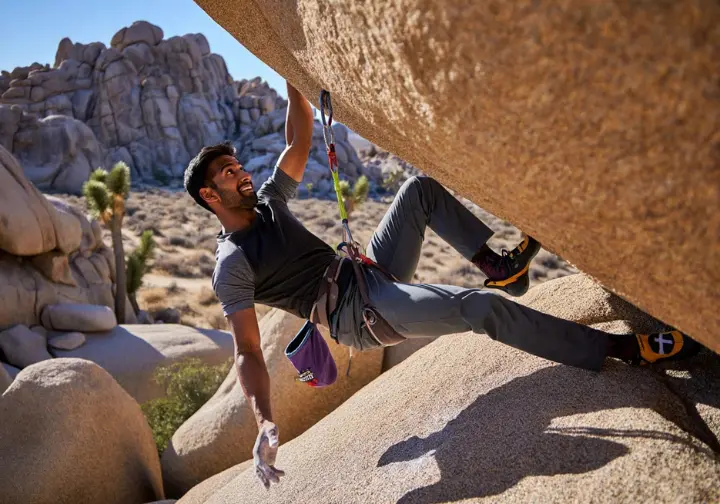
This section serves as your core guide to some of the most popular and classic bouldering areas within Joshua Tree. We’ll highlight their distinct character, typical access, and point you towards a few must-do famous boulder problems. A good Joshua Tree bouldering guidebook is indispensable for truly unlocking the potential of these zones. This is your joshua tree bouldering guide to top areas and rock climbs.
Hidden Valley Campground (HVCG): The Epicenter
Hidden Valley Campground (HVCG) is arguably the most iconic joshua tree and easily accessible bouldering area, a true landmark. Countless boulder problems are located directly within and immediately surrounding the campground, making it a bustling hub for climbers from around the globe. You can find Hidden Valley bouldering area details on various online platforms like Mountain Project.
This climbing area offers an incredibly high concentration of both historic and modern classic boulder problems, including many 5-star granite climbs. These span a wide range of grades, making it suitable for climbers of various skill levels, from the new climber to experts. Access is typically straightforward, either from the main Intersection Rock parking lot or directly from campsites if staying there.
Classic boulder problems abound in Hidden Valley. For those starting out, “Nitwit” (V0) is a friendly introduction. “False Up 20” (V0-/V1) offers a taste of J-Tree highballs. More seasoned climbers will seek out the renowned “Stem Gem” (V4) or the legendary thin face problem found at the classic JBMF Boulders information, “JBMFP” (V5).
Due to its immense popularity and ease of access, be prepared for crowds, especially during peak season weekends and holidays. Always be mindful of other visitors, including non-climbing campers, and practice good crag etiquette.
The Outback: Quality Lines and Highballs
Located just north of Hidden Valley Campground, The Outback is one of the most heavily trafficked bouldering zones in Joshua Tree. It’s celebrated for its exceptional quality of easy to moderate lines, often found on smooth, tan-colored rock adorned with distinct dark patina holds. An Outback bouldering zone overview will show its proximity to HVCG, a central part of the tree area.
Access to The Outback is straightforward. Climbers can walk north through Hidden Valley Campground from the Intersection Rock parking lot, or park at Roadside Turnout 2 and approach from there. The area boasts a high density of boulder problems, ensuring plenty of options even on busy days. More details on bouldering in The Outback details can be found on community climbing sites.
Notable classics in The Outback include the fun and dynamic “Flintlock Dyno” (V0), a must-do for many visitors. “Chuckawalla” (V1) is a beautiful boulder problem showcasing typical Outback features. For those seeking a bit more spice, the famous and committing highball “White Rastafarian” (V2/V3 R) is a true test of nerve and technique, a unique boulder experience.
The area’s popularity means it can certainly be busy, particularly on prime climbing days. However, the sheer number of boulder problems spread across various joshua rock formations usually allows climbers to find something to work on without excessive waiting.
Barker Dam & Gunsmoke Area: Traverses and Testpieces
This broader climbing area encompasses several sub-zones, with the Gunsmoke Area being particularly popular among boulderers. It’s well-known for its long, engaging traverses and a diverse array of individual boulder problems. Reaching the Gunsmoke Area typically requires a 10-minute or longer hike north from the Barker Dam parking lot. General Barker Dam bouldering information can give you a lay of the land for these rock climbs.
The rock character in the Barker Dam and Gunsmoke vicinity is varied, offering different textures and hold types compared to some other central areas. This zone often provides a slightly more secluded climbing experience than the bustling hubs of HVCG or The Outback. For specifics on boulder problems, consult Gunsmoke area bouldering details on Mountain Project.
Key boulder problems that draw climbers to this climbing area include “The Chube” (V2), a classic slanting crack that tests technique and body positioning. The quintessential “Gunsmoke Traverse” (V3) is a long and pumpy endurance challenge, a true benchmark for the grade in J-Tree. For those operating at a higher level, harder testpieces like “Streetcar Named Desire” (V6/V6-7) offer significant climbing challenges.
The Barker Dam Nature Trail itself is a popular hike for general park visitors, and the area can attract non-climbers, especially around the dam. As always, be mindful of shared use of these beautiful natural spaces and strive to minimize your impact on the boulders and surrounding vegetation.
Exploring Further: Planet X, Real Hidden Valley, and Cap Rock
Planet X offers a good selection of boulder problems ranging from easy to hard. It’s particularly known for the namesake highball arete, “Planet X” (V6 R), a striking and intimidating climbing line. However, easier lines like “Sweetie Pie” (VB) – not to be confused with the “Illicit Sweetie Boulder” which is a different classic – provide more accessible options. Access typically involves an eastward hike from a pullout located south of HVCG. You can find listings for Planet X bouldering problems in online databases.
Real Hidden Valley (RHV), along with the adjacent Turtle Rock circuit, provides a vast selection, especially for easy to moderate bouldering, with some notable highballs like “So High” (V5 R) and the photogenic dyno “Saturday Night Live” (V4). These formations offer days of exploration for the adventurous climber.
Cap Rock, easily accessible from its parking area and nature trail, features an excellent circuit of moderate slab problems (V0-V3) and some of the park’s hardest classics like “All Washed Up” (V6) and “Palm-o-Granite” (V7). A Cap Rock bouldering area guide will detail these and many other climbs, including the nearby Headstone Rock and Pothole Rock.
Many other significant bouldering areas exist throughout Joshua Tree, including Lost Horse, Indian Cove (home to the Manx Boulders), and Jumbo Rocks, each offering unique bouldering challenges and emphasizing the need for a good guidebook to truly explore Joshua Tree’s bouldering potential across its cliffs and boulders. Some might even say it rivals places like Castle Rock State Park for outdoor bouldering variety.
Safety First: Essential Practices for Joshua Tree Bouldering
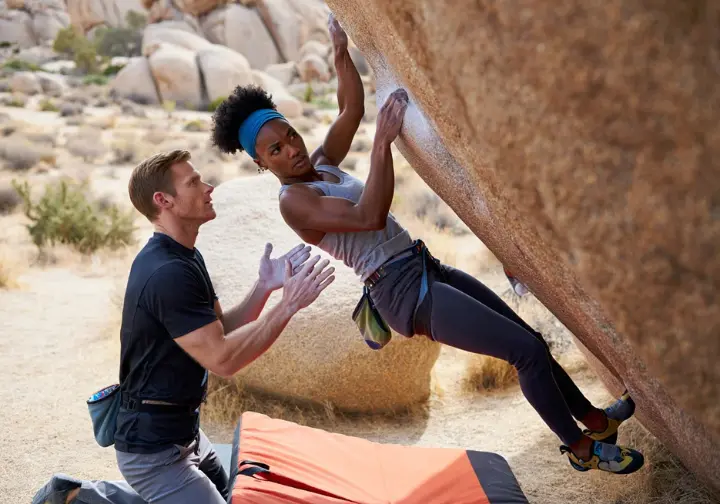
While the allure of Joshua Tree’s boulders is strong, safety must always be the foremost consideration for every climber. This section underscores the critical importance of adhering to general climbing best practices, being aware of specific desert environment hazards, and ensuring adequate emergency preparedness in Joshua Tree’s uniquely challenging terrain. This is your joshua tree bouldering guide to staying safe.
Fundamental Climbing Safety Protocols
Always climb within your ability and be honest about your limits. Joshua Tree grades can often feel “stiff” or “old school” compared to modern gym climbing grades or other major outdoor areas. It’s wise to start on boulder problems easier than you might typically climb elsewhere to get a feel for the rock and grading style. The National Park Service offers advice on climbing safety in Joshua Tree.
Before committing to a boulder problem, thoroughly assess rock stability. Check for loose or wobbly rocks, especially on top-outs or less-traveled lines. If a hold looks suspect, test it gently with your hand or foot before fully weighting it. This diligence is part of mastering movement and route safety for any climber.
Effective spotting by attentive partners and strategic crash pad placement are vital for mitigating fall consequences. Ensure your pads cover the potential fall zone, paying particular attention to eliminating gaps and covering hazardous rocks or uneven ground, especially on taller problems or those involving sloper climbing. This is especially important for highball boulder problems. While this guide focuses on bouldering, understanding essential gear for Joshua Tree trad climbing can also provide insights into the serious nature of J-Tree climbing for lead climbers and those engaging in rope climbing.
Always scope out your descent route before you top out a boulder. Getting stuck on top of a boulder, unable to find a safe way down, is a surprisingly common issue. Never ascend what you cannot safely descend. For highball boulder problems or in areas with potential rockfall, consider wearing a helmet. Some climbers—Joshua Tree regulars included—swear by them.
Navigating Desert-Specific Environmental Hazards
Dehydration is a major and serious risk in the desert environment of Joshua Tree. You must carry and drink an adequate amount of water – a minimum of one gallon (approximately 4 liters) per person per day is the standard recommendation. In warmer conditions, or during strenuous activity like tree climbing (though not the focus here, it illustrates exertion), your water needs will be even higher. Remember that water sources within the park are very limited and often not potable. The NPS provides safety guidelines for visiting Joshua Tree which include hydration.
Protect yourself from the intense desert sun. Use high SPF sunscreen liberally and reapply throughout the day. Wear a wide-brimmed hat to shield your face and neck, and use sunglasses to protect your eyes. Seek shade during the hottest parts of the day, especially from late spring to early fall. You can find general park goods and services information, including where to get water outside the park.
Be acutely aware of the symptoms of heat illness, which can include dizziness, weakness, nausea, headache, and confusion. If you are climbing in warmer months, it’s best to start very early in the morning, take a long break during the heat of the day, and resume climbing late in the afternoon or evening. Alternatively, seek out boulders that are in the shade.
Be mindful of desert wildlife. Rattlesnakes are present in the park; avoid placing your hands or feet in crevices or under rocks without looking first. Bees can also be encountered, sometimes aggressively, especially if their hives are disturbed. If you hear a loud buzzing sound or see many bees, calmly and quickly move away from the area. Remember the caveman didn’t have bug spray!
Emergency Preparedness and Self-Reliance in J-Tree
Cell service is unreliable or completely non-existent in most areas of Joshua Tree National Park. You absolutely should not depend on your phone for emergencies or for navigation while in the climbing areas. Download all maps, guidebook information (perhaps from a book by a noted author like Robert Miramontes or even National Geographic maps), and any other digital resources for offline use before you lose service. The Mountain Project app is a great project to have offline.
Emergency telephones are located at the Intersection Rock parking area (near Hidden Valley Campground) and at the Indian Cove Ranger Station. When visitor centers and entrance stations are open, you can also seek assistance there. For urgent situations, Joshua Tree Search and Rescue information (JOSAR) details how to get help, though response times can be significant.
Leave a detailed itinerary with someone reliable who is not on your trip. This itinerary should include your planned climbing areas, your intended routes or general objectives, your expected return time, and emergency contact information for the park. You can find park contact information on the NPS website.
Carry a well-stocked first-aid kit that goes beyond basic skin care items. Be prepared for self-rescue. Due to the park’s remoteness, rugged terrain, and limited communication, professional help can take hours, or even longer in some situations, to arrive. Self-reliance is a key component of safe J-Tree adventuring.
Leave No Trace: Protecting Joshua Tree’s Unique Desert Ecosystem
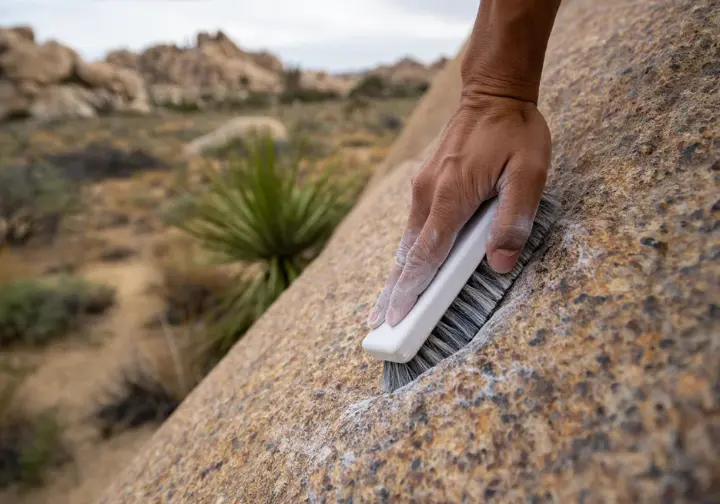
Every climber who visits Joshua Tree shares a crucial responsibility: to protect its fragile desert environment. Adhering strictly to Leave No Trace principles and specific park regulations is essential to ensure this unique landscap remains pristine for future generations. This is your joshua tree bouldering guide to ethical practices.
Core Leave No Trace Principles for Boulderers
Plan ahead and prepare thoroughly for your trip. This includes knowing current park regulations, being aware of any potential closures (e.g., for wildlife nesting), and understanding local conditions. Traveling in small groups helps to minimize impact on trails and at bouldering sites. Familiarize yourself with good climbing practices in national parks.
Travel and camp on durable surfaces. Always use established trails and climber access paths when approaching boulders. Avoid creating “social trails” or shortcuts, as these can damage fragile cryptobiotic soil crusts, which are vital to the desert ecosystem and its vegetation. The goal is protecting climbing environments for everyone.
Dispose of all waste properly. This means pack out everything you pack in. This includes not just obvious trash like food wrappers and bottles, but also smaller items like tape scraps, chalk pieces, cigarette butts, and even fruit peels or nut shells. Use restroom facilities where available, or follow park guidelines for human waste disposal if you are in the backcountry. It is part of understanding climbing rules and ethics.
Leave what you find. Do not chip, “garden” (remove vegetation from holds), or otherwise alter rock formations to improve a climb. Resist the urge to remove lichen or plants from holds. Do not cut or damage any vegetation, including the iconic Joshua trees themselves. These large landmark formations of rock are precious.
J-Tree Specifics: Chalk Use, Cultural Sites, and Wildlife
Minimize your chalk use to prevent unsightly white streaks that detract from the natural beauty of the rock. When you are finished with a boulder problem, make an effort to brush off your chalk holds and any tick marks you may have made. Some climbers even opt to use chalk colored to match the local rock where appropriate. This is part of the J-Tree speak or local etiquette.
Joshua Tree National Park has a rich cultural history, which includes significant Native American rock art sites (pictographs and petroglyphs) and other archaeological resources. These sites are legally protected and culturally sensitive. Do not touch rock art under any circumstances. Climbing within 50 feet of any rock art is strictly prohibited. Be aware of current climbing closures in Joshua Tree, some of which may be for cultural resource protection.
Respect all wildlife by observing from a distance and never feeding animals. Be aware of seasonal wildlife closures, particularly for nesting raptors (birds of prey), which often occur from late February through July. Always check the official NPS website or visitor centers for the most current information on closures before heading out. The park sometimes provides Climbing Management Plan updates that address these issues.
Pets must be on a leash no longer than 6 feet at all times and are only permitted within 100 feet of a road, parking area, or campground. They are generally not encouraged at crags or bouldering areas due to potential impacts on wildlife and the environment. Always pick up and properly dispose of pet waste.
Beyond the Boulders: Other Activities and Attractions in J-Tree
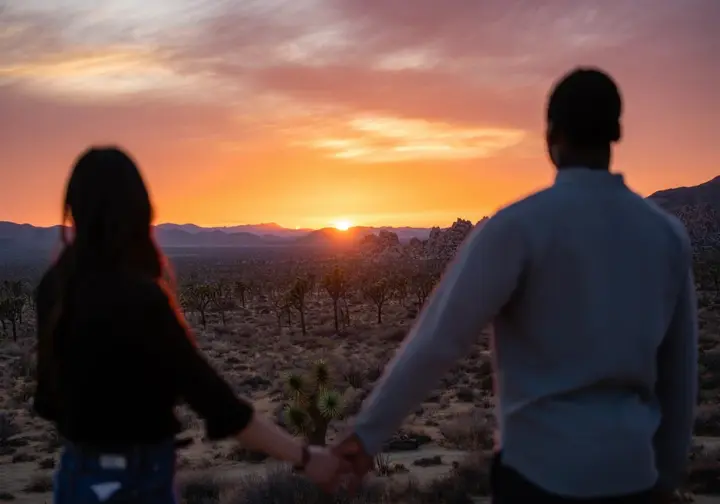
While bouldering might be your primary objective, Joshua Tree National Park and its surrounding areas offer a wealth of other activities and attractions. Exploring these can enrich your visit, provide active rest day options, or offer alternatives if climbing conditions are not ideal. These are not just bouldering challenges but opportunities for broader adventure.
Hiking, Stargazing, and Scenic Park Views
Joshua Tree boasts a diverse network of hiking trails, catering to all fitness levels. Options range from easy, family-friendly nature walks like the Hidden Valley Nature Trail and the Skull Rock Nature Trail, to more strenuous treks such as the ascent of Ryan Mountain, which rewards hikers with panoramic park views. You can find information on many hiking trails in Joshua Tree on the park’s website, some of which might be National Geographic Trails. Some unique adventure hikes in Joshua Tree can also be found through local guiding companies, often incorporating some scrambling. Good mobility for hiking performance will make these more enjoyable.
The park’s remote location and typically clear desert air make it an exceptional location for stargazing. Far from city lights, the night skies can be breathtakingly dark, revealing the Milky Way and countless stars. Popular spots for setting up a telescope or simply lying back and observing include Keys View, the area around Skull Rock, and the vicinity behind White Tank Campground. The park sometimes hosts Night Sky Festivals, drawing astronomy enthusiasts.
Keys View is the highest point accessible by road within Joshua Tree National Park. It offers stunning panoramic vistas that stretch across the Coachella Valley, often reaching as far as the Salton Sea and even Signal Mountain in Mexico on clear days. Another unique landscap worth a short visit is the Cholla Cactus Garden, where a nature trail winds through a dense concentration of these fascinating, fuzzy-looking cacti.
Exploring Nearby Towns and Unique Desert Sites
Just outside the park, Pioneertown offers a quirky and enjoyable experience. Originally built as an 1880s Western movie set in the 1940s, it still functions with shops, some eateries, and the famous Pappy & Harriet’s Pioneertown Palace, a renowned live music venue and restaurant. For Pioneertown visitor information, check their local website.
The gateway towns of Joshua Tree, Yucca Valley, and Twentynine Palms provide essential amenities like grocery stores, gas stations, and restaurants. They also host a vibrant arts scene with numerous art galleries (such as the eclectic Glass Outhouse Art Gallery), small museums like the Hi-Desert Nature Museum, and unique local shops offering crafts and souvenirs. A one day itinerary for Joshua Tree area might include some of these town stops.
The Integratron, located near Landers (a short drive from Joshua Tree town), is a unique structure with a fascinating history involving claims of UFOs and rejuvenation. Today, it’s primarily known for its “sound baths,” meditative experiences using quartz crystal bowls, offering a distinct and memorable desert experience.
For nature lovers seeking a different desert environment, the Big Morongo Canyon Preserve, situated between Joshua Tree and Palm Springs, is a lush oasis. This riparian area is a popular spot for birdwatching and features several nature walks through its verdant canyon.
Key Takeaways for Your Joshua Tree Bouldering Adventure
Joshua Tree offers a lifetime of bouldering discovery. To make the most of your adventure, remember these core points. Thorough planning is absolutely paramount. This means understanding the distinct seasons and their impact on climbing conditions, booking accommodations well in advance or having a solid plan for competitive first-come, first-served joshua tree camping, and, critically, downloading all necessary maps and guide information (perhaps from books or the Mountain Project app) before you lose cell service.
Pack appropriate and sufficient climbing gear. Durable climbing shoes suited to sharp granite, multiple crash pads for varied landings, and a robust skin care kit are non-negotiable. Ample water – at least one gallon (or 4 liters) per person per day – and comprehensive sun protection are essential for desert survival and comfort.
Always prioritize safety. Climb within your personal limits, especially given J-Tree’s reputation for stiff grades and serious stonemaster classics. Utilize attentive spotters and ensure proper, strategic crash pad placement for every boulder problem. Be acutely aware of desert-specific hazards such as extreme heat, dehydration, and encounters with local wildlife, and always have a well-thought-out emergency plan. Even famous climbers like Lynn Hill would prioritize safety here.
Practice meticulous Leave No Trace ethics. Stay on trails, pack out every single piece of trash (including organic matter and tape), minimize chalk use and clean holds after climbing, and show utmost respect for cultural and natural resources. This helps preserve Joshua Tree’s unique environment for all climbers.
Embrace the entire adventure. Joshua Tree is more than just a collection of boulder problems; it’s an experience. Use this j-tree climbing guide as your starting point, invest in a good area-specific bouldering book (many guides are available), and allow yourself to enjoy the unique challenge and beauty of this world-class outdoor bouldering destination, from its slabby faces to its taller highballs.
Frequently Asked Questions about Your Joshua Tree Bouldering Guide
What’s the single most essential piece of gear for bouldering in Joshua Tree, besides shoes and a crash pad? >
Are the bouldering grades in Joshua Tree really harder than in my gym or other outdoor areas? >
Can I just boulder anywhere I see rocks in Joshua Tree National Park? >
What’s the best strategy to protect my hands and skin from the sharp Joshua Tree rock? >
We are a participant in the Amazon Services LLC Associates Program, an affiliate advertising program designed to provide a means for sites to earn advertising fees by advertising and linking to Amazon.com. As an Amazon Associate I earn from qualifying purchases. We also participate in other affiliate programs. The information provided on this website is provided for entertainment purposes only. We make no representations or warranties of any kind, expressed or implied, about the completeness, accuracy, adequacy, legality, usefulness, reliability, suitability, or availability of the information, or about anything else. Any reliance you place on the information is therefore strictly at your own risk. Additional terms are found in the terms of service.



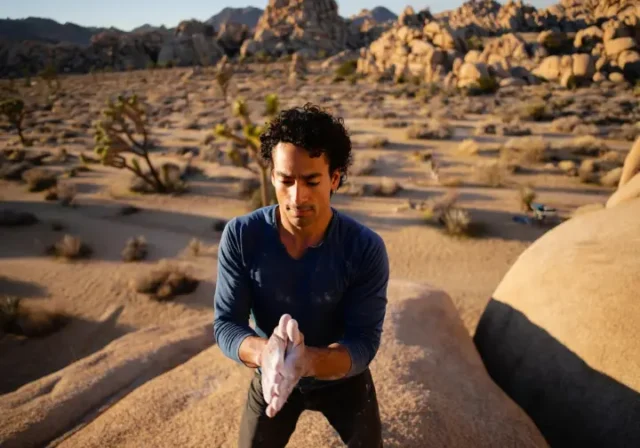

![Boise Idaho Rock Climbing: Crags, Gyms & Beta [Guide] Boise Idaho rock climbing guide: diverse female climber topping out at The Black Cliffs, showcasing crags, gyms, and beta.](https://rockclimbingrealms.com/wp-content/uploads/2025/03/01-boise-idaho-rock-climbing-crags-gyms-beta-guide-238x178.webp)





